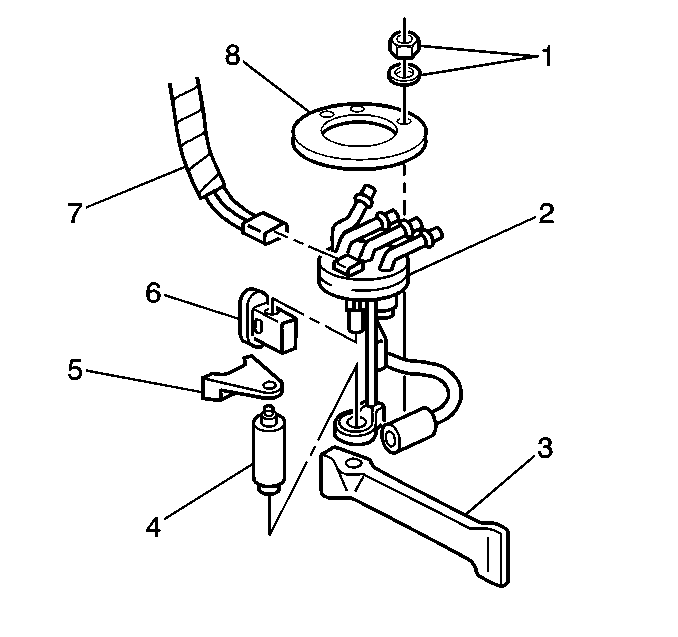Removal Procedure
Caution: Unless directed otherwise, the ignition and start switch must be in the OFF or LOCK position, and all electrical loads must be OFF before servicing
any electrical component. Disconnect the negative battery cable to prevent an electrical spark should a tool or equipment come in contact with an exposed electrical terminal. Failure to follow these precautions may result in personal injury and/or damage to
the vehicle or its components.
- Remove the
negative battery cable.
- Relieve the fuel system pressure. Refer to
Fuel Pressure Relief
.
- Disconnect the following components:
| • | The EVAP pipe quick-connect fittings at fuel sender assembly |

- Remove the following components:
| • | The fuel sender assembly electrical connector (7) |
| • | The 6 nuts and washers (1) retaining the fuel sender assembly
lock ring (8). |
| • | Support and slide out the tank until the fuel sender assembly clears
the cab. |
| • | The fuel pump sender assembly |
| • | The seal from the fuel tank |
- Disconnect the fuel pump electrical connector.
- Remove the fuel pump strainer from the bottom of the fuel pump.
- Rotate the strainer in one direction and pull the strainer off
the pump. Discard the strainer after inspection.
Important: Do not damage the rubber insulator.
- Remove the fuel pump (4) from the sender assembly (2). Pull the fuel
pump up into the attaching hose while pulling outward from the bottom support.
- Inspect the fuel pump attaching hose for signs of deterioration.
- Inspect the rubber sound insulation at the bottom of the pump.
Installation Procedure

Important: Care should be taken not to fold over or twist the strainer (3), when
installing the sender assembly as this will restrict fuel flow.
- Install the fuel pump assembly (4) into the attaching hose.
- Install the fuel pump strainer.
- Connect the fuel pump electrical connector.
- Install the new seal, sender assembly (2), and lock ring (8) in
the fuel tank.
Make sure the lock ring alignment holes fit over the tabs on the tank.
Notice: Use the correct fastener in the correct location. Replacement fasteners
must be the correct part number for that application. Fasteners requiring
replacement or fasteners requiring the use of thread locking compound or sealant
are identified in the service procedure. Do not use paints, lubricants, or
corrosion inhibitors on fasteners or fastener joint surfaces unless specified.
These coatings affect fastener torque and joint clamping force and may damage
the fastener. Use the correct tightening sequence and specifications when
installing fasteners in order to avoid damage to parts and systems.
- Install the washers
and nuts (1) retaining the fuel sender assembly lock ring.
Tighten
Tighten the lock ring nuts to 11.5 N·m (100.90 lb
in).
- Install the fuel tank. Slide the tank into the original position.
- Install the following components:
| • | The EVAP pipe quick-connect fittings at fuel sender assembly |
- Install the fuel sender assembly electrical connector (7).
- Install the negative battery cable.
- Inspect for fuel leaks using the following procedure:
| 10.1. | Turn the ignition switch to ON position for 2 seconds. |
| 10.2. | Turn the ignition switch to OFF for 10 seconds. |
| 10.3. | Turn the ignition switch to ON position. |
| 10.4. | Inspect for fuel leaks. |


